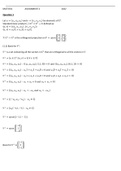MAT3701 ASSIGNMENT 2 2022
Question 1
Let 𝑢 = (𝑢1 , 𝑢2 , 𝑢3 ) and 𝑣 = (𝑣1 , 𝑣2 , 𝑣3 ) be elements of ℂ3 .
Standard inner product 〈, 〉: ℂ3 × ℂ3 → ℂ defined as:
〈𝑢, 𝑣〉 = 〈(𝑢1 , 𝑢2 , 𝑢3 ) , (𝑣1 , 𝑣2 , 𝑣3 )〉
〈𝑢, 𝑣〉 = 𝑢1 ̅̅̅
𝑣1 + 𝑢2 ̅̅̅
𝑣2 + 𝑢3 ̅̅̅ 𝑣3
1 0
𝑇: ℂ3 → ℂ3 is the orthogonal projection on 𝑉 = 𝑠𝑝𝑎𝑛 {[1] , [1]}.
0 1
(1.1) Basis for 𝑉 ⊥ .
𝑉 ⊥ is a set containing all the vectors in ℂ3 that are orthogonal to all the vectors in 𝑉.
𝑉 ⊥ = {𝑢 ∈ ℂ3 : 〈𝑢, 𝑣〉 = 0, ∀ 𝑣 ∈ 𝑉 }
𝑉 ⊥ = {(𝑢1 , 𝑢2 , 𝑢3 ) ∶ 〈(𝑢1 , 𝑢2 , 𝑢3 ), (1,1, 0)〉 = 0 𝑎𝑛𝑑 〈(𝑢1 , 𝑢2 , 𝑢3 ), (0,1, 1)〉 = 0}
𝑉 ⊥ = {(𝑢1 , 𝑢2 , 𝑢3 ) ∶ 𝑢1 1̅ + 𝑢2 1̅ + 𝑢3 0̅ = 0 𝑎𝑛𝑑 𝑢1 0̅ + 𝑢2 1̅ + 𝑢3 1̅ = 0}
𝑉 ⊥ = {(𝑢1 , 𝑢2 , 𝑢3 ) ∶ 𝑢1 1 + 𝑢2 1 + 𝑢3 0 = 0 𝑎𝑛𝑑 𝑢1 0 + 𝑢2 1 + 𝑢3 1 = 0}
𝑉 ⊥ = {(𝑢1 , 𝑢2 , 𝑢3 ) ∶ 𝑢1 + 𝑢2 = 0 𝑎𝑛𝑑 𝑢2 + 𝑢3 = 0}
𝑉 ⊥ = {(𝑢1 , 𝑢2 , 𝑢3 ) ∶ 𝑢1 = −𝑢2 𝑎𝑛𝑑 𝑢3 = −𝑢2 }
𝑉 ⊥ = {(−𝑢2 , 𝑢2 , −𝑢2 ) ∶ 𝑢2 ∈ ℂ}
𝑉 ⊥ = {𝑢2 (−1,1, −1) ∶ 𝑢2 ∈ ℂ}
𝑉 ⊥ = 𝑠𝑝𝑎𝑛{(−1,1 − 1)}
−1
𝑉 ⊥ = 𝑠𝑝𝑎𝑛 {[ 1 ]}
−1
−1
⊥
Basis for 𝑉 is {[ 1 ]}.
−1
,(1.2) Matrix representation of 𝑇 with respect to the canonical basis for ℂ3 .
1 0 0
Canonical basis for ℂ3 , 𝛽 = {[0] , [1] , [0]} where scalars are complex numbers.
0 0 1
1 0
𝑇: ℂ3 → ℂ3 is the orthogonal projection on 𝑉 = 𝑠𝑝𝑎𝑛 {[1] , [1]}.
0 1
Let 𝑣1 = (1,1, 0) 𝑎𝑛𝑑 𝑣2 = (0,1, 1)
〈𝑢, 𝑣〉 = 𝑢1 ̅̅̅
𝑣1 + 𝑢2 ̅̅̅
𝑣2 + 𝑢3 ̅̅̅
𝑣3
𝑇(𝑢) = 〈𝑢, 𝑣1 〉𝑣1 + 〈𝑢, 𝑣2 〉𝑣2
1 0 0
Apply 𝑇 on , 𝛽 = {[0] , [1] , [0]}
0 0 1
𝑇((1,0,0)) = 〈(1,0,0), (1,1, 0)〉(1,1, 0) + 〈(1,0,0), (0,1, 1)〉(0,1, 1)
𝑇((1,0,0)) = [1 × 1 + 0 × 1 + 0 × 0](1,1, 0) + [1 × 0 + 0 × 1 + 0 × 1](0,1, 1)
𝑇((1,0,0)) = [1](1,1, 0) + [0](0,1, 1)
𝑇((1,0,0)) = (1,1, 0)
𝑇((0,1,0)) = 〈(0,1,0), (1,1, 0)〉(1,1, 0) + 〈(0,1,0), (0,1, 1)〉(0,1, 1)
𝑇((0,1,0)) = [0 × 1 + 1 × 1 + 0 × 0](1,1, 0) + [0 × 0 + 1 × 1 + 0 × 1](0,1, 1)
𝑇((0,1,0)) = [1](1,1, 0) + [1](0,1, 1)
𝑇((0,1,0)) = (1,2, 1)
𝑇((0,0,1)) = 〈(0,0,1), (1,1, 0)〉(1,1, 0) + 〈(0,0,1), (0,1, 1)〉(0,1, 1)
𝑇((0,0,1)) = [0 × 1 + 0 × 1 + 1 × 0](1,1, 0) + [0 × 0 + 0 × 1 + 1 × 1](0,1, 1)
𝑇((0,0,1)) = [0](1,1, 0) + [1](0,1, 1)
𝑇((0,0,1)) = (0,1, 1)
, 1 1 0
[ 𝑇 ] 𝛽 = [1 2 1]
0 1 1
Question 2
Let 𝑔 and ℎ be elements of 𝑃2 (ℝ) and 𝑎, 𝑏 and 𝑐 ∈ ℝ are distinct.
Inner product 〈, 〉: 𝑃2 (ℝ) × 𝑃2 (ℝ) → ℝ defined as:
〈𝑔, ℎ〉 = 𝑔(𝑎)ℎ(𝑎) + 𝑔(𝑏)ℎ(𝑏) + 𝑔(𝑐 )ℎ(𝑐 )
The inner product satisfies:
Let 𝑓, 𝑔 and ℎ ∈ 𝑃2 (ℝ) and 𝑘 ∈ ℝ.
IP1 〈𝑓 + ℎ, 𝑔〉 = 〈𝑓, 𝑔〉 + 〈ℎ, 𝑔〉
IP2 〈𝑘𝑓, 𝑔〉 = 𝑘〈𝑓, 𝑔〉
IP3 〈𝑓, 𝑔〉 = 〈𝑔, 𝑓〉
IP4 (a) 〈𝑓, 𝑓〉 ≥ 0
(b) 〈𝑓, 𝑓〉 = 0 if and only if 𝑓 = 0
The set 𝛽 = {𝑓𝑎 , 𝑓𝑏 , 𝑓𝑐 } of Lagrange polynomials associated with 𝑎, 𝑏 and 𝑐 respectively is a basis for 𝑃2 (ℝ).
The Lagrange polynomials satisfy:
1.
𝑓𝑎 (𝑎) = 1
𝑓𝑏 (𝑏) = 1
𝑓𝑐 (𝑐 ) = 1
2.
𝑓𝑎 (𝑏) = 0 = 𝑓𝑎 (𝑐)
𝑓𝑏 (𝑎) = 0 = 𝑓𝑏 (𝑐)
𝑓𝑐 (𝑎) = 0 = 𝑓𝑐 (𝑏)
Let 𝑃: 𝑃2 (ℝ) → 𝑃2 (ℝ) be the orthogonal projection on
1 1
𝑊 = 𝑠𝑝𝑎𝑛 { (𝑓𝑎 + 2𝑓𝑏 + 2𝑓𝑐 ), (2𝑓𝑎 − 2𝑓𝑏 + 𝑓𝑐 )}
3 3
(2.1) Show that 〈𝑎1 𝑓𝑎 + 𝑏1 𝑓𝑏 + 𝑐1 𝑓𝑐 , 𝑎2 𝑓𝑎 + 𝑏2 𝑓𝑏 + 𝑐2 𝑓𝑐 〉 = 𝑎1 𝑎2 + 𝑏1 𝑏2 + 𝑐1 𝑐2 ∀ 𝑎1 , 𝑎2 , 𝑏2 , 𝑏2 , 𝑐1 , 𝑐2 ∈ ℝ.
Solution
After applying IP1 repeatedly, we get:
〈𝑎1 𝑓𝑎 + 𝑏1 𝑓𝑏 + 𝑐1 𝑓𝑐 , 𝑎2 𝑓𝑎 + 𝑏2 𝑓𝑏 + 𝑐2 𝑓𝑐 〉
= 〈𝑎1 𝑓𝑎 , 𝑎2 𝑓𝑎 + 𝑏2 𝑓𝑏 + 𝑐2 𝑓𝑐 〉 + 〈𝑏1 𝑓𝑏 , 𝑎2 𝑓𝑎 + 𝑏2 𝑓𝑏 + 𝑐2 𝑓𝑐 〉 + 〈𝑐1 𝑓𝑐 , 𝑎2 𝑓𝑎 + 𝑏2 𝑓𝑏 + 𝑐2 𝑓𝑐 〉
After applying IP3 on each term on the RHS, we get:
〈𝑎1 𝑓𝑎 + 𝑏1 𝑓𝑏 + 𝑐1 𝑓𝑐 , 𝑎2 𝑓𝑎 + 𝑏2 𝑓𝑏 + 𝑐2 𝑓𝑐 〉
= 〈𝑎2 𝑓𝑎 + 𝑏2 𝑓𝑏 + 𝑐2 𝑓𝑐 , 𝑎1 𝑓𝑎 〉 + 〈𝑎2 𝑓𝑎 + 𝑏2 𝑓𝑏 + 𝑐2 𝑓𝑐 , 𝑏1 𝑓𝑏 〉 + 〈𝑎2 𝑓𝑎 + 𝑏2 𝑓𝑏 + 𝑐2 𝑓𝑐 , 𝑐1 𝑓𝑐 〉




